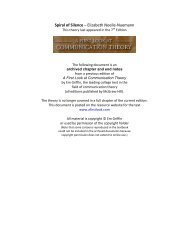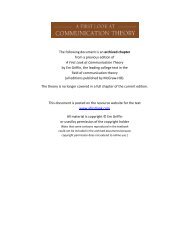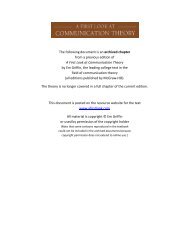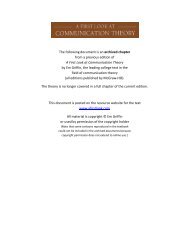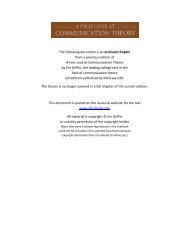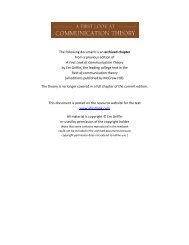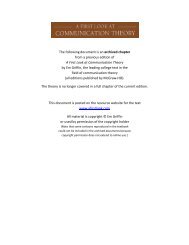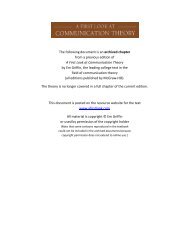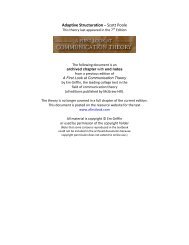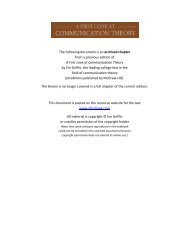Interpersonal Deception Theory (PDF) - A First Look at ...
Interpersonal Deception Theory (PDF) - A First Look at ...
Interpersonal Deception Theory (PDF) - A First Look at ...
- No tags were found...
You also want an ePaper? Increase the reach of your titles
YUMPU automatically turns print PDFs into web optimized ePapers that Google loves.
CHAPTER 7: INTERPERSONAL DECEPTION THEO/{)105trust th<strong>at</strong> is held without sufficient evidence or proof."l" As such, they picture suspicionas a midrange mindset loc<strong>at</strong>ed somewhere between truth and falsity:TRUE SUSPICION FALSEWe've already looked <strong>at</strong> the str<strong>at</strong>egic and nonstr<strong>at</strong>egic behavior of deceiversth<strong>at</strong> might cause others to become suspicious. Verbal tactics of vagueness, nonimmediacy,and disassoci<strong>at</strong>ion can make respondents wary; nonverbal signs of emotionalstress and mental meltdown may put listeners on guard. In fact, any communic<strong>at</strong>ionth<strong>at</strong> strikes respondents as strange or out of character is liable totrigger misgivings about the message or the messenger. Of course, some suspicionsmay be planted before the interaction even begins. From past experience, P<strong>at</strong>may know th<strong>at</strong> you aren't always truthful. Certainly P<strong>at</strong>'s jealousy will cre<strong>at</strong>e abuilt-in skepticism toward any explan<strong>at</strong>ion you might offer. Or a prior warningfrom a third party could taint the whole interaction.Given the many ways th<strong>at</strong> respondents could become suspicious, we mightimagine th<strong>at</strong> deceivers would lose their truth-bias advantage and have their deceptionunmasked for wh<strong>at</strong> it is. Not so. Buller and Burgoon have found th<strong>at</strong> it'sactually difficult to induce a deep-se<strong>at</strong>ed skepticism.20 On the rare occasions whenrespondents are highly suspicious, their doubts usually diminish after a few minutesof interaction.When respondents doubt a deceiver's honesty, they tend to avoid direct confront<strong>at</strong>ionin order to hide their suspicions. Instead, they adopt "a take charge interviewstyle but one th<strong>at</strong> is conducted under a pleasant guise."21 Smiling often,they gently probe for more inform<strong>at</strong>ion r<strong>at</strong>her than directly challenging the deceiver'sst<strong>at</strong>ements. Buller and Burgoon have discovered scant evidence th<strong>at</strong> theseprobes help respondents unmask deception. On the contrary, the theorists findth<strong>at</strong> throughout the interaction, respondents are "oblivious to, or accepting of,sender deceit and may even assist, wittingly or unwittingly, in its cre<strong>at</strong>ion."22 Eventhough Buller and Burgoon's empirical commitment contrasts sharply with Pearceand Cronen's interpretive stance (see Chapter 5), interpersonal deception theoryand CMM reach a common conclusion-namely, th<strong>at</strong> persons-in-convers<strong>at</strong>ionco-construct their own social realities. This construction project continues as thedeceiver reacts to the respondent's suspicions.PUTTING DOUBTS TO REST: DECEIVER ADJUSTMENT TO SUSPICIONIn the early stages of her work on interpersonal deception, Judee Burgoon st<strong>at</strong>edth<strong>at</strong> researchers should view deception as a "chain of offensive and defensive maneuverson the part of both participants."23 Propositions 12-18 describe the ongoinginteraction in th<strong>at</strong> adversarial "game." Just as unexpected words and nonverballeakage reveal the str<strong>at</strong>egic thinking and emotional stress th<strong>at</strong> accompanydeception, respondents' suspicions can be seen through their own nontypical behaviors-evenwhen they try to appear n<strong>at</strong>ural. The deception game isn't balanced,however. Unlike truth-bias players who don't even know they are playing,



